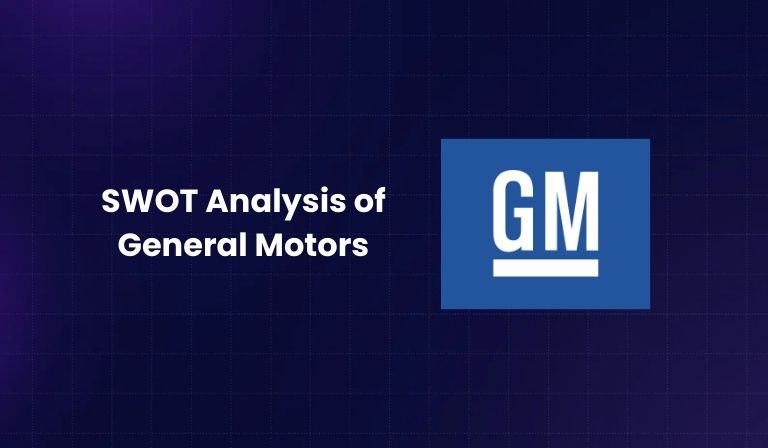Summary
General Motors (GM) is one of the most recognized automotive brands in the world. Founded in 1908, the company has survived recessions, technological disruptions, and intense competition to remain a global leader. In 2025, GM is doubling down on electric vehicles (EVs), autonomous driving, and connected mobility solutions to secure its future.
- Strengths: Powerful brand portfolio, global presence, safety leadership, R&D innovation, economies of scale.
- Weaknesses: Dependence on the U.S. market, labor disputes, product recalls, heavy legacy costs.
- Opportunities: Rapid EV adoption, emerging market growth, partnerships in tech, software-driven vehicles, sustainability initiatives.
- Threats: Semiconductor shortages, rising raw material prices, intense competition, cybersecurity risks, market saturation in North America.
This SWOT Analysis of General Motors (Updated 2025) explores each factor in depth and provides insights into how GM can strengthen its global position.
General Motors (GM) is not just another car manufacturer—it is an automotive icon. With brands like Chevrolet, GMC, Cadillac, and Buick, GM has a diversified lineup that caters to different customer segments worldwide. Headquartered in Detroit, Michigan, GM has been a pioneer in mass production, safety standards, and automotive technology for over a century.
In 2025, the global auto industry is shifting faster than ever before, driven by electric mobility, digitalization, and sustainability. GM is racing ahead with its Ultium battery platform, Cruise autonomous division, and software-defined vehicles. But at the same time, it faces challenges like rising competition, market volatility, and consumer preference shifts.
Let’s dive into a comprehensive SWOT analysis of General Motors (Updated 2025) to understand how its strengths, weaknesses, opportunities, and threats shape its strategic direction.
Company Overview
- Founded: September 16, 1908
- Headquarters: Detroit, Michigan, U.S.
- CEO & Chair: Mary Barra
- Brands: Chevrolet, GMC, Buick, Cadillac
- Global Operations: 396 facilities across six continents
- Revenue (2023): Approx. $171.8 billion
- Focus Areas (2025): EVs, autonomous driving, connected mobility, sustainability
SWOT Analysis of General Motors (2025)
Strengths of General Motors
- Strong Brand Portfolio
GM owns multiple strong brands:
- Chevrolet: Affordable, mass-market appeal.
- GMC: Trusted for trucks and SUVs.
- Buick: Mid-level premium brand.
- Cadillac: Flagship luxury brand competing with BMW and Mercedes.
This variety allows GM to capture customers across different income levels and preferences, reducing dependency on a single segment.
- Global Presence
GM operates in over 22 time zones, six continents, and 75+ languages. It has manufacturing, assembly, and distribution networks spread across North America, South America, Europe, Africa, and Asia. This global reach ensures market diversification and resilience during regional downturns. - Safety Leadership
General Motors is the only automaker to achieve a five-star safety rating across its entire vehicle lineup. This safety-first approach boosts consumer trust and brand credibility, a key differentiator in today’s competitive market. - Legacy & Reputation
With over 115 years in the automotive industry, GM has built a heritage of trust, innovation, and resilience. Its strong reputation continues to draw customers who value tradition combined with modern innovation. - Manufacturing Expertise
GM runs over 1,500 U.S. facilities, including assembly, component, stamping, and battery plants. This scale gives GM superior production expertise, supply chain control, and quality assurance compared to smaller players. - Economies of Scale
As one of the world’s largest automakers, GM benefits from bulk purchasing, standardized production, and shared platforms. This reduces costs and enhances profit margins even in a competitive pricing environment. - Research and Development (R&D)
GM spent $9.9 billion in R&D (2023). Its Ultium battery platform, Cruise self-driving technology, and software-defined vehicle strategy are examples of how GM uses innovation to stay ahead of rivals. - Strategic Partnerships & JVs
Through alliances with SAIC and FAW in China, GM gains access to the world’s largest EV market. These JVs provide GM with local market expertise and help in scaling EV adoption globally. - GM Financial
This financial arm provides leasing, loan, and financing solutions, making cars more accessible while ensuring steady income streams for GM. - Commitment to Sustainability
GM has pledged to launch 30 EV models globally by 2025 and aims to be carbon neutral by 2040. This aligns with global sustainability goals and appeals to eco-conscious customers and investors.
Weaknesses of General Motors
- Dependence on U.S. Market
Around 17% of GM’s sales come from the U.S., making the company vulnerable to domestic market downturns, interest rate hikes, or regulatory changes. - Labor Relations Challenges
GM has a long history of strikes and union conflicts, which disrupt production and lead to financial losses. - Brand Dilution
While Toyota and Honda rely heavily on their flagship brands, GM spreads across multiple brands. This sometimes dilutes brand equity and confuses customers. - Revenue Concentration in SUVs & Trucks
GM’s profits are heavily dependent on SUVs and pickup trucks, especially in North America. Any decline in these segments can hurt overall performance. - Product Recalls
GM recalled 820,000 pickup trucks in 2024 due to safety issues. Frequent recalls increase costs and erode consumer confidence. - Legacy Costs
High pension and healthcare costs for retired employees put financial strain on GM and reduce flexibility in allocating funds for R&D. - Slow Adaptation in the Past
GM was slower than Tesla in capturing the EV market. While it is now catching up, the delay in innovation cost it early leadership in electrification.
Opportunities for General Motors
- Eco-Friendly and EV Market Growth
The EV market is booming, and GM is positioned with its Ultium battery technology to launch multiple electric models across its brand portfolio. - Expansion in Emerging Markets
GM has relatively small footprints in Africa, Southeast Asia, and Latin America. With rising incomes and car ownership, these regions provide long-term growth opportunities. - Autonomous Vehicle Expansion
GM’s Cruise subsidiary is at the forefront of self-driving technology. The growing market for robotaxis and autonomous delivery services provides GM with future revenue streams. - Mobility Services
With consumer preferences shifting from ownership to mobility solutions, GM can expand its offerings in ride-hailing, car-sharing, and subscription models. - Digitalization & Connectivity
GM’s focus on software-defined vehicles, connected infotainment, and over-the-air updates can create recurring revenue from digital features. - Sustainability Leadership
As regulations tighten, GM can strengthen its brand by being a leader in green manufacturing and renewable energy usage. - Customization & Personalization
Offering special edition vehicles, personalized interiors, and modular features can help GM attract younger consumers seeking individuality.
Threats to General Motors
- Semiconductor Shortages
Chip supply issues have already led to halted production lines and delayed launches, affecting revenue streams. - Rising Manufacturing Costs
The surge in raw material costs (steel, aluminum, lithium) and labor wages is squeezing margins. - Intense Competition
GM faces tough competition from Tesla, Toyota, Hyundai, BYD, and new EV startups. - Declining U.S. Market
As the U.S. auto market reaches saturation, GM must find new growth outside North America. - Shift in Consumer Preferences
Urbanization and younger generations’ preference for shared mobility over ownership could reduce long-term vehicle sales. - Cybersecurity Risks
As vehicles become more connected, the risk of data breaches, hacking, and system failures increases. - Raw Material Price Volatility
The demand for lithium, cobalt, and nickel in EV batteries exposes GM to raw material price swings. - Geopolitical Risks
Trade wars, tariffs, and political instability in key markets (like China) may disrupt GM’s supply chains.
Strategic Implications
To remain a global leader, GM must:
- Diversify revenue beyond trucks and SUVs.
- Scale EV adoption faster with competitive pricing.
- Strengthen presence in Asia and Africa.
- Lead in autonomous mobility through Cruise.
- Enhance cybersecurity and supply chain resilience.
- Balance legacy costs while accelerating R&D in future mobility.
Conclusion
General Motors (GM) in 2025 is at a turning point. It has the brand strength, global scale, and R&D capabilities to remain a leader in the auto industry. However, to secure long-term success, it must move faster in electrification, autonomous driving, and digital services while addressing weaknesses like U.S. dependency and legacy costs.
With opportunities in EV growth, sustainability, and emerging markets, GM’s strategic decisions in the next few years will decide whether it stays ahead of rivals or risks falling behind in the race for the future of mobility.
FAQs
What is General Motors’ biggest strength in 2025?
Its diverse brand portfolio and global presence combined with heavy R&D investments in EVs and autonomous vehicles.
What is GM’s biggest weakness?
Overdependence on the U.S. truck and SUV market, along with high pension and healthcare legacy costs.
What opportunities can GM leverage?
Expansion in emerging markets, EV leadership with Ultium technology, and new mobility services like ride-hailing and subscriptions.
What are the main threats to GM?
Semiconductor shortages, intense EV competition, cybersecurity risks, and raw material price volatility.
How is GM preparing for the future?
GM plans to launch 30 EV models by 2025, scale Cruise for autonomous driving, and build sustainable operations to stay competitive.

